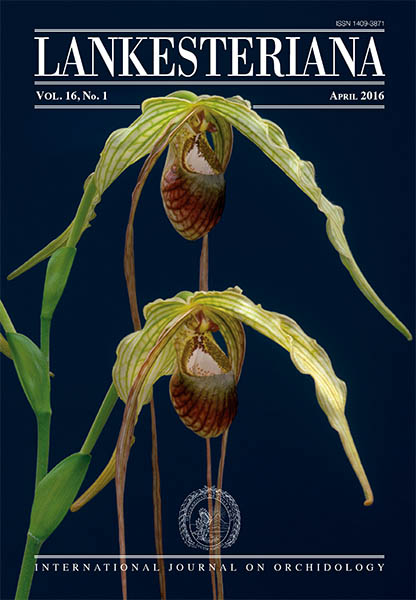Ecología y estructura poblacional del endemismo cubano <i>Tetramicra malpighiarum</i> (Orchidaceae), en el Parque Nacional Desembarco del Granma, Cuba
DOI:
https://doi.org/10.15517/lank.v16i1.23379Keywords:
clases de vida, distribución vertical, forófito, Malpighia incana, orientación cardinalAbstract
In Cuba, there are 315 species of Orchidaceae family, approximately 32 % of these species are endemic. During 2012 and 2013 an endemic population of Tetramicra malpighiarum (Orchidaceae) was studied at the Desembarco del Granma National Park, Cuba. We determined the abundance of this species, life classes (immature and adult), phorophytes inhabited, vertical distribution (trunk, branches or twigs), solitary or aggregated growing, and its cardinal orientation on phorophytes. We found 254 individuals of T. malpighiarum distributed in 20 phorophytes. For the first time, were found individuals of T. malpighiarum grew on other five species of phorophytes, besides of Malpighia incana (Malpighiaceae) and Erythroxylum havanense (Erythroxylaceae). Of the total of individuals recorded, 69.3 % were adult and 93.7 % were growing on the twigs. The number of solitary individual and aggregated individuals was similar. The population shows a slight tendency to grow toward south and northwest orientations. This is the first study to describe the population ecology of T. malpighiarum, but it is recommended to conduct long-term genetic and demographic studies. These future studies should be explored the reproductive system (e.g., level of endogamy) and population genetic of this species endemic of Cuba in order to evaluate its permanency in the future.
Downloads
Downloads
Published
How to Cite
Issue
Section
License
According to the Open Access policy promoted by the University of Costa Rica, all the papers published by Lankesteriana are licensed under the Creative Commons copyright and can be downloaded free of charge. The journal holds copyright and publishing rights under the CC BY-NC-ND 3.0 CR license.
Before the publication of the materials submitted by the author(s) in LANKESTERIANA, the author(s) hereby assign all rights in the article to the Lankester Botanical Garden.





